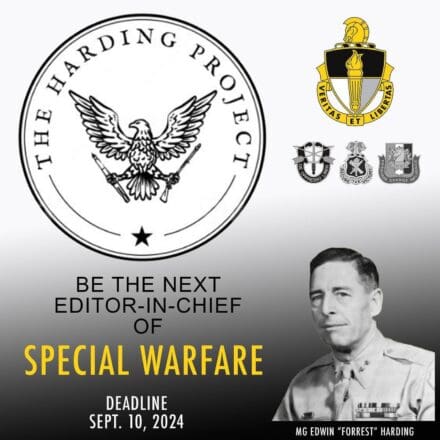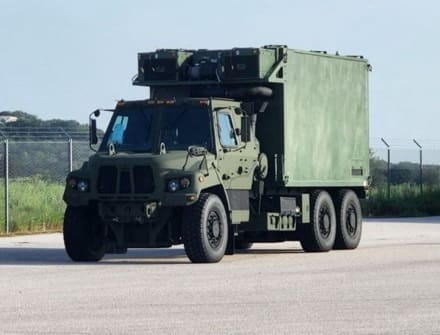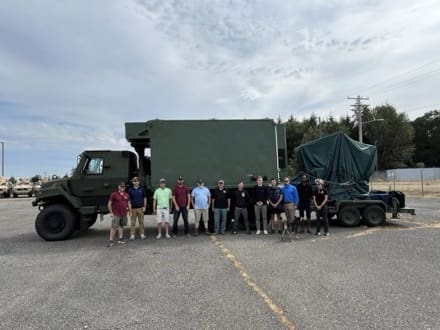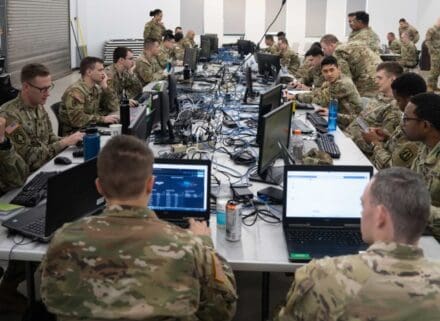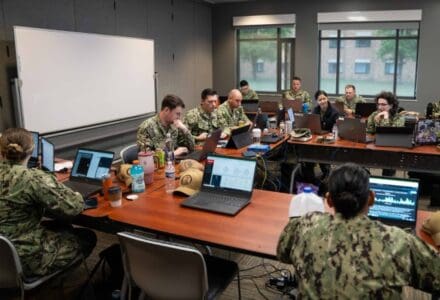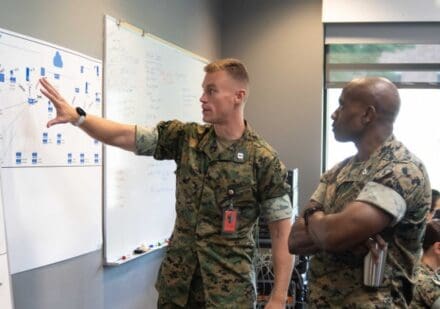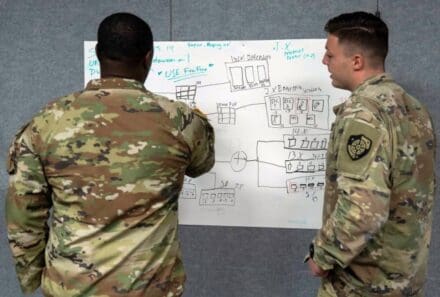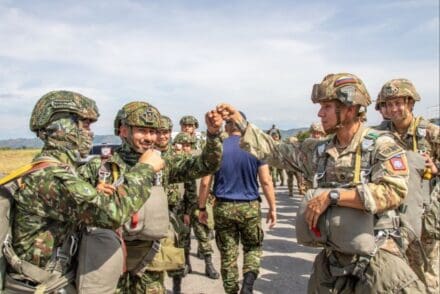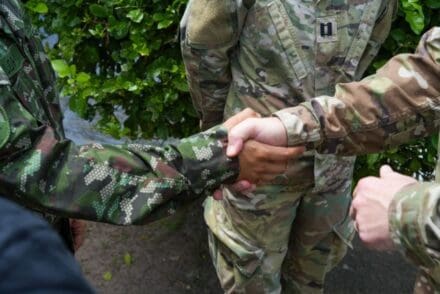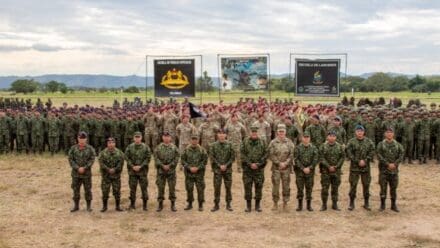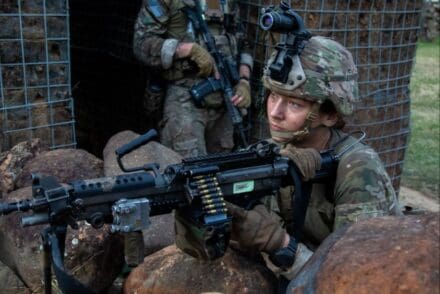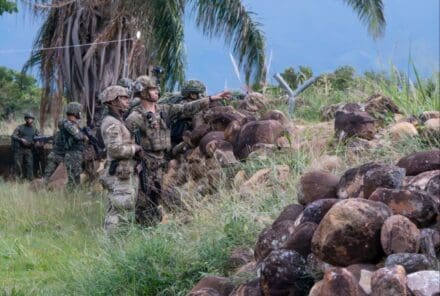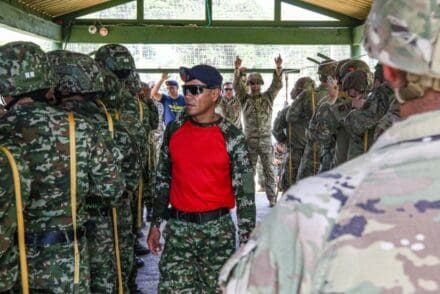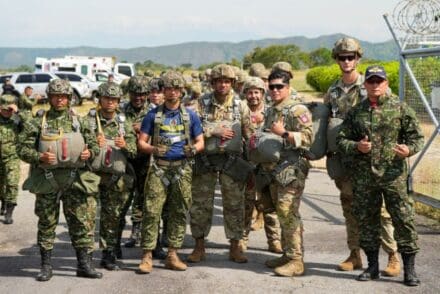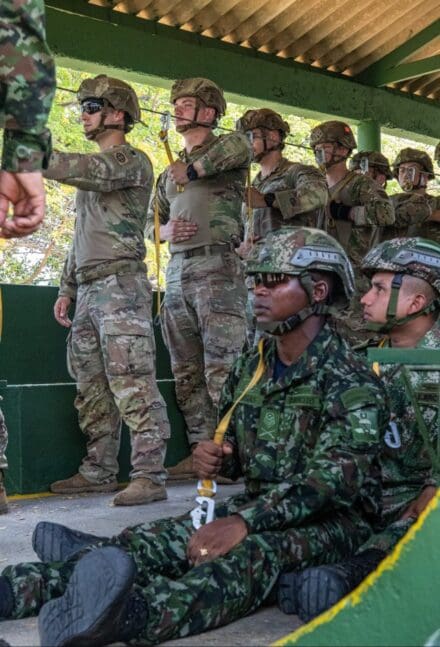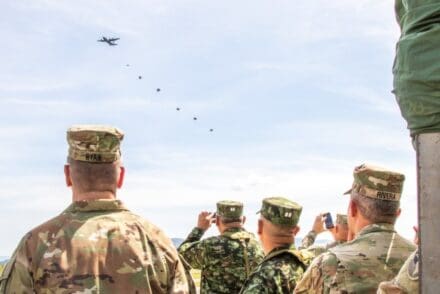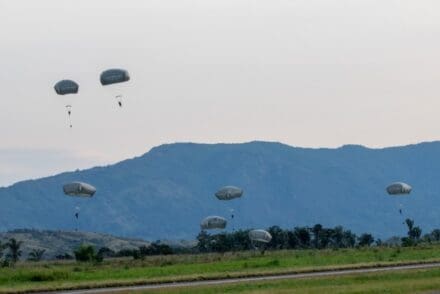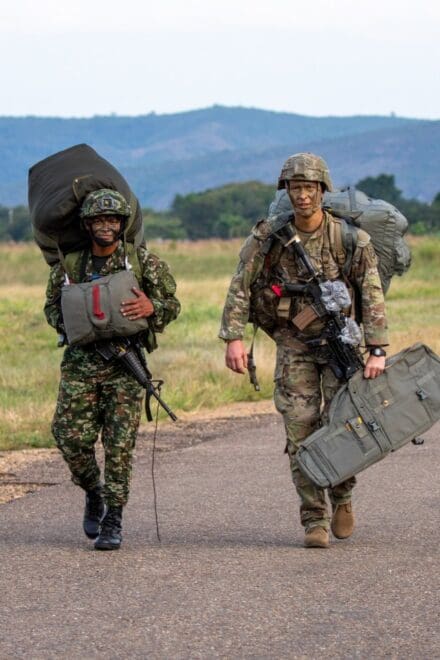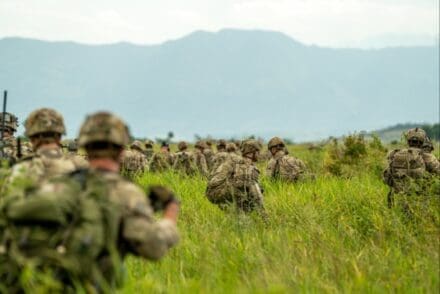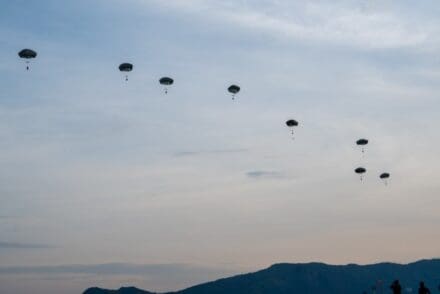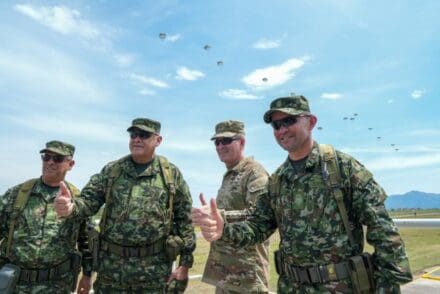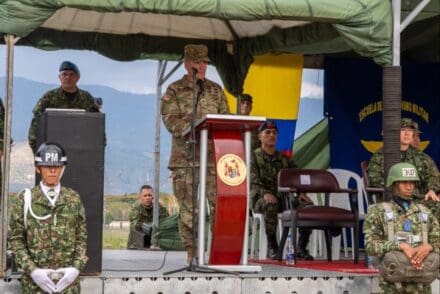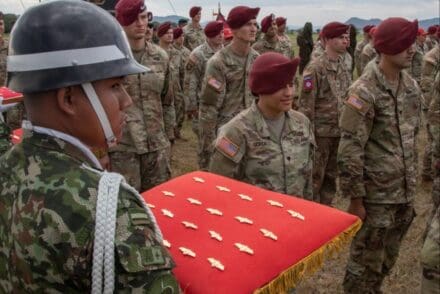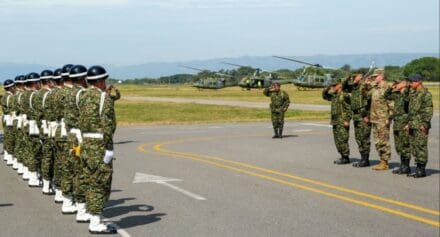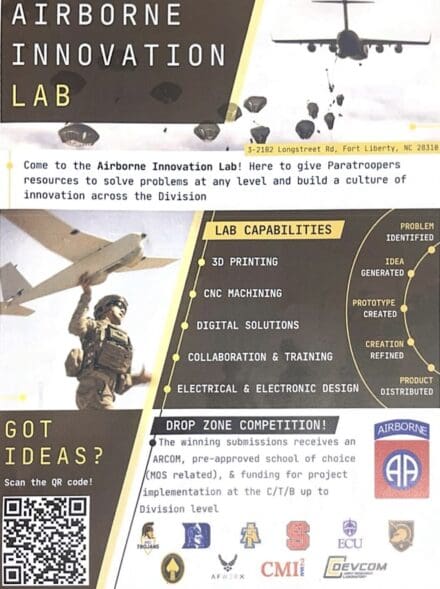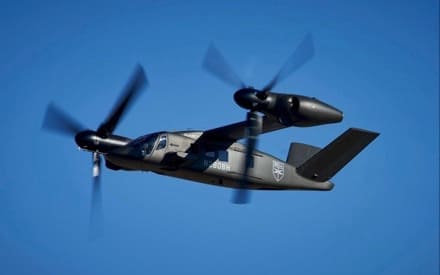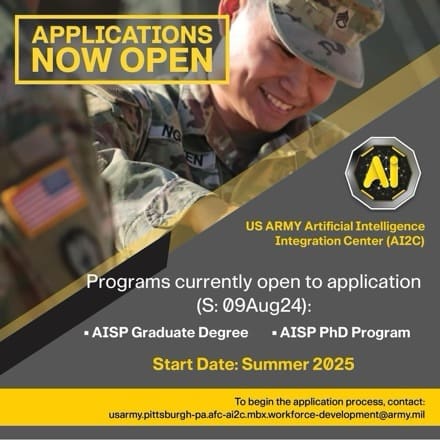
FORT KNOX, Ky. — Elite parachutists, marksmen, cross fitters, gamers, fishermen and musicians can serve full time in one special Army command.
The U.S. Army Recruiting Command’s Marketing and Engagement Brigade is the home of the the Army’s Golden Knights, Marksmanship Unit, Musical Outreach Team, Warrior Fitness Team, eSports Team and an Outdoors Team.
History, mission
The brigade was founded in 1997 as a support group under U.S. Army Recruiting Command. It was restructured and re-aligned under other units until it once again officially became the Marketing and Engagement Brigade under Recruiting Command in 2018. This includes the U.S. Army Mission Support Battalion, based in Fort Knox, with the brigade headquarters, the Army Marksmanship Unit on Fort Benning, Georgia, and the Army Parachute Team on Fort Liberty, North Carolina.
The Marketing and Engagement Brigade influences people to join the Army by enhancing and conducting recruiting operations through direct engagements and demonstrating elite Army skills and exhibits to achieve the Army’s recruiting mission, said Capt. Mimi Mejia, U.S. Army Recruiting Command marketing and engagement brigade outreach company commander.
The overall program puts out all calls once or twice a year per team with a list of what they’re looking for, the requirements and expectations, she said.
“The key to being on any of the teams is these teams represent the Army on the world stage,” she said. “They need to represent the Army in everything they do. They are Soldiers first. We take our profession seriously as Soldiers, and our next priority is serving in the fields we compete in.”
“No unit in the Army shoots more, drives more miles or jumps more than the Army Marketing and Engagement Brigade,” she said. “We employ the latest technology to produce exhibits that travel to towns and events across each state to share the Army experience. Our Soldiers log more than 75,000 miles each year to help connect people with the Army.”
She said each athlete easily puts in 70-hour weeks to be experts in their respective fields.

Army Marksmanship Unit
In 1956, President Dwight D. Eisenhower authorized the formation of the Army Marksmanship Unit, almost exclusively to win shooting competitions that would raise the standards of marksmanship throughout the Army, said Mejia.
From 1962 to 1978, the unit earned the United States six Olympic Gold Medals and 59 individual and team championships in international competitions. The unit provides marksmanship training to thousands of Soldiers and became the leader in small-arms research and development.
From 2009 to 2012, the AMU maintained a constant presence in Afghanistan by deploying multiple marksmanship training teams in support of the Afghan National Army NATO training mission.
The unit is composed of five competitive shooting sections, each with world-class training facilities and competition grounds. These teams include service rifle, action shooting, international rifle, service pistol and shotgun. The shotgun and international rifle teams have represented the U.S. during every summer Olympics since 1960 and have earned 24 Olympic medals since that time.
The unit builds and customizes small arms and ammunition through the Custom Firearms Shop. The Army’s finest gunsmiths, machinists, range technicians and ammunition loaders staff the shop, said Mejia.
“They are the backbone, or ‘pit crew’ of the marksmanship teams,” she said. “The custom firearm shop’s research and development efforts have led to enhanced accuracy and reliability of the Army’s competitive weapon systems and ammunition and have intensified the combat effectiveness of the entire Army.”
M21 and M24 sniper systems, special purpose rifles and squad designed marksman rifles were developed and tested in the shop, she said.
Follow the Army Marksmanship Unit on Facebook and Instagram.

Golden Knights
These exhibits and demonstrations are important so the public can better understand the Army mission and interact with Soldiers, said Lt. Col. Alan Wilson, Army Parachute Team battalion commander.
“Due to the nature of the Army’s mission abroad, many of our nation’s citizens have limited contact and exposure to Soldiers and their families,” he said. “The Golden Knights serve to connect America’s people to their Army by showcasing modern sport parachute exhibitions that pay homage to the Army’s daring and historic airborne operations.”
Since 1959, the Army Parachute Team, the Golden Knights, represents the Army through cutting edge aerial parachute demonstrations and competitions nationally and internationally. The team consists of more than 100 active-duty Soldiers and Defense Department civilians.
Wilson said their enhanced aerial demonstrations highlight the pinpoint precision of their ram air accuracy canopies, synchronized freefall and canopy formations, gravity-defying wing suiting and high-performance landings.
Their modified Viking Twin Otter planes serve as the backbone of the team and provide the perfect paradrop platforms to deliver their jumpers on target anywhere in the country in plus or minus 30 seconds, he said.
“As we enter our 65th year of aviation and parachuting excellence, I extend our sincere thanks and appreciation for the trust you’ve placed in us to fulfill our mission of representing the Army and our nation pride and distinction,” he said. “The team has a long tradition of professionalism, teamwork, safety, and camaraderie that will pave the way for future generations. We’re excited and grateful to share that tradition of service with everyone at the more than 100 events we perform each year.”
Follow the Golden Knights on Facebook and Instagram.
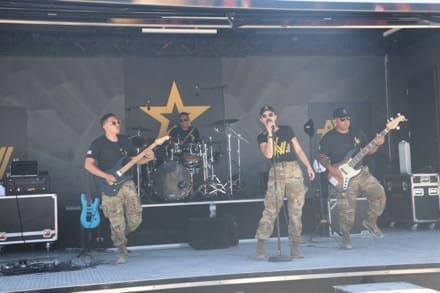
Musicians
The current Musical Outreach Team form the band, “As You Were.” They perform contemporary pop and rock music at high schools and events across the nation to build awareness of the Army and the career opportunities available.
“Just being out there and sharing our message and being able to play for all these people is the best part of the job,” said lead singer Sgt. 1st Class Jessica Gatlin during one of her many concerts on the road.
The band plays three-day concerts such as the iHeart Country Music Festival. The band has released three albums with original music. Performing at events gives band members the opportunity to share original music and Army messages on stage.
“They’re the only band in the Army that writes and produces their own music in the rock and pop genres,” Mejia said. “They travel all over the United States performing different shows. They drive, set up and tear down their own equipment. They’re their roadies. We don’t have an operations center. They’re very self-sufficient.”
Gatlin has been a team leader, squad leader and talent manager for the band. Sgt. 1st Class John Dowler serves as the audio technician and operations noncomissioned officer for the band. Dowler has been an instrumentalist, team leader and operations NCO for the band.
Staff Sgt. Abiud Flores-Rodriguez is the bassist for As You Were. He’s been a musician and operations NCO. Staff Sgt. Kenneth Goss is the drummer for the band. He’s been a team leader, squad leader, senior musician and senior support NCO.
Follow the Army Music Outreach Team and As You Were on Facebook and Instagram.

Warrior Fitness Team
The Warrior Fitness Team consists of nationally and internationally ranked CrossFit and strongman athletes.
“They are really high performing,” Mejia said. “One of our athletes just got third in the world. Our male and female athletes are highly ranked at the national and international level. They’re incredible athletes.”
U.S. Military Academy graduate 1st Lt. Vince Wilkinson competes as a strongman athlete. He said the discipline, resiliency and fitness it takes to become an elite athlete translates over into any career path in the Army. He also said the team enjoys sharing their fitness journey with their fans on social media.
The enlisted and officers on the team also mentor each other professionally so they can progress in their Army career fields, he said.
Having the athletes sharing fitness tips with their fans at the expos is a great way to bridge that gap between the American public and the Army, Mejia said.
Follow the Warrior Fitness Team on Facebook and Instagram.
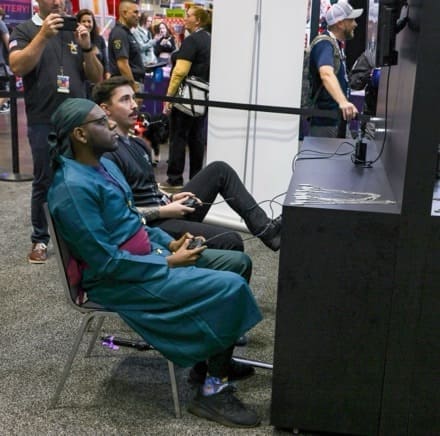
eSports Team
Active-duty and Reserve Soldiers compete in eSports competitions across the nation.
“Soldiers have expressed a strong desire to represent the Army in competitive gaming,” Mejia said. “They’ve shown Army leaders how gaming can help us connect to young people. This helps make our Soldiers more relatable.”
Sgt. Eduardo Gonzaga, who goes by the gamer name “EJ,” put in about 6,500 hours or about 150 days into the game Apex Legends to get ready for his competition matches. He said he loves to compete for the Army and meet other gamers and fans who follow his streams.
“We talk nonstop, and I hang out with them. We follow the same streamers,” he said. “I still talk to most of them to this day.”
He said the conventions are a great way to show the public another side of the Army.
“We’re more than just infantry,” he said. “This is my life; I love eSports.”
Follow the Army eSports Team on Facebook and Instagram.
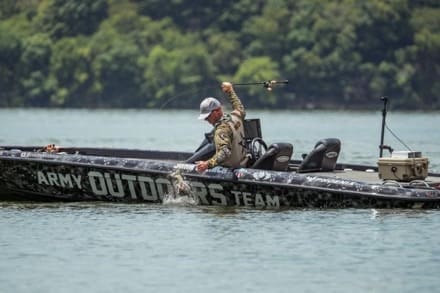
Outdoors Team
The Outdoors Team currently has two fishing anglers, Master Sgt. Josh Watkins and Master Sgt. John Branch.
Watkins serves as a competitive angler on the National Professional Fishing League for the U.S. Army Outdoors Team at Fort Knox. He grew up in Illinois and joined the Army in 2005 as a military police officer. He’s served multiple deployments to Iraq and Afghanistan.
Watkins, a third generation Army Soldier, received his invitation to compete in the National Professional Fishing League circuit, an invite reserved for a select few anglers each year, in 2022.
“It’s an unbelievable honor,” he said. “We get to do what we love for a living.” Hodge stated. “By creating the Outdoors Team, the Army is giving us the opportunity to engage with our target audience through a shared passion.”
He said the Army helped him achieve this feat.
“People think we just go out on a boat, throw a line out and wait for a fish,” Watkins said. “But there is so much more that goes into it. We are battling the elements, heat, cold, rain, waves and wind for hours on end,” Watkins said.
“Maintaining our physical training to Army standards has certainly prepared us for that.” “It even gives us an edge,” Hodge joked. “We are well prepared.”
Hodge tied for ninth place at the National Professional Fishing League Tournament, or NPFL, in Pickwick Lake, Tennessee, July 7-12, 2024.
Branch, who’s been fishing for 37 years, said he relied on skill, dedication and a little luck to capture the team’s first top 10 national finish out of 122 anglers on the lake.
The NFPL provides a stage for anglers to demonstrate their skills in front of a national audience.
“The NFPL is the Army Outdoor Team’s primary tournament circuit that we participate in,” Branch said. “They have six events throughout the year all across the country.”
The NFPL finish is a steppingstone for the Army Outdoor team, which represents the Army motto of “Be All You Can Be.”
“The freedom … it’s just you outdoors with the fish,” Branch said. “It’s something that I was born with. I was extremely young when my father got me into it. I couldn’t imagine life without it. Fishing is a part of who I am.”
“My number one fishing secret is that you have to understand a fish,” Branch said. “Any time you can get them to bite, it’s luck. Whatever lure they’re biting that day is my favorite.”
He said the Outdoors Team is small but mighty.
“We’re the only team reaching out to that demographic and in my opinion the most important aspect of our team is simply the awareness that you are not a Soldier 24/7,” Branch said. “You have time to chase your hobbies, chase your dreams and your passions. Watkins and I are both prime examples of this. We both fished competitively in our off time prior to this team.”
Mejia said the Outdoor Team currently has two fishing anglers on the team but they’re looking to expand their reach, to include hunters, archers, a rodeo team, bull riding and other outdoor sports.
“They have a folder dedicated to rodeo with more than 2,000 athletes applying, Soldiers from across all these different professions, just think about the talent that lies in the Army,” Mejia said.
Follow the Outdoors Team on Facebook and Instagram.
Mejia said any Soldiers who are considering trying out for any of the U.S. Army Recruiting Command’s Marketing and Engagement Brigade’s teams should keep an eye out for the all calls and apply.
For more information, visit the Marketing and Engagement Brigade’s official website.
By Shannon Collins, ARNEWS


